MoonRunner
By Alejandro Cid, Manan Rai, Noel Sarduy
Artists’ Statement
Since the ideation phase, we knew we wanted to create an experience in the vein of dark sci-fi fantasy classics like Titanfall, Dune, and Blade Runner. We wanted to give the player an instant hit of wonder and amazement, followed by compelling gameplay in an interesting world.
Our game sets itself apart through its lore and the implications of the lore on its gameplay. The protagonist of MoonRunner is a cyborg that crash lands on a mysterious, ruined planet which it explores to find upgrades for its machine body. Eventually, it encounters a more advanced version of itself from the future which attempts to destroy it. The story of MoonRunner alludes to the ancient symbol of the Ouroboros from ancient Egyptian and Greek tradition. The gradual upgrades our protagonist acquires are represented in the game as physical pickups; in the first level, the modules collected fell from the protagonist’s ship as it crash landed, but later on the protagonist would learn to extract skills and powers directly from its environment.
We felt a movement-focused platforming stage would be the best option for our game’s vertical slice. It gave us a direction in terms of level design, where the player could unlock double jumping, wall running, and a grapple hook within the first level. We could design obstacles to teach the player to use these abilities properly. Our vertical slice ends with a cutscene, so we could tease the story for the rest of the game.
Game at a Glance
Setting
You awaken on an alien planet, reeling from the crash of your spaceship. As you regain control of your robotic body, you remember that you were sent here to defeat an unnamed God-like being that desecrated the planet. To do so, you must make your way to this creature, but the planet seems unnavigable, having morphed to prevent you from achieving your goals, until you realize that as you move through the world, you recover the faculties you seem to have lost during the crash.
Lore
MoonRunner is a game of time loops and fighting one’s inner demons. Long before the last written records of human history end, the human race created robotic machines called the Runners to help protect the planets they lived on and keep peace between settlements. But one of these machines, now known as the Rogue, saw eradicating humanity as the only way to serve its purpose, and it destroyed all life everywhere. Only one fleet of Runners survived, now known as the Keepers. Several Runners have since been sent on missions to defeat the Rogue, most of them never to be heard back from. Those that did return were called the Founders, and their missions helped the Keepers learn that the Rogue had found a moon made of chromantium, an element that gave it the power to alter quantum fields. Some data indicates that it may have found the way to restore parts of the universe to a past state, achieving results similar to what humans understood as time travel. Your mission is yet another attempt to beat the Rogue. But along the way you begin to suspect that a deeper plot may be unfolding. As you progress, you gain more powerful abilities, which are reminiscent of the abilities that the Rogue is said to possess. Are you simply learning new tricks, or turning into the Rogue itself?
Overview
MoonRunner is a single-player 3D platformer with a heavy emphasis on hand parkour, built for PC. Players control a robot character to traverse an obstacle course on an alien planet, acquiring abilities along the way that help them progress. The game offers movement puzzles that the player must solve using the abilities they have unlocked thus far, in order to complete the level.
Target Audience
We created MoonRunner for experienced gamers looking for an engaging single player experience. Many of the movement mechanics of our game feel very natural for people accustomed to typical video game controls, but can be off-putting to beginners. That being said, we designed our first level to naturally teach beginners how to use the various movement abilities in our game in order to broaden our target audience. The target audience may be the most frequently tapped market for video games: experienced gamers looking for a dark, violent, graphically impressive, sci-fi experience.
Notable Elements of the Game
Objective
MoonRunner is divided into levels, with the goal of each level being to reach a designated “waypoint.”
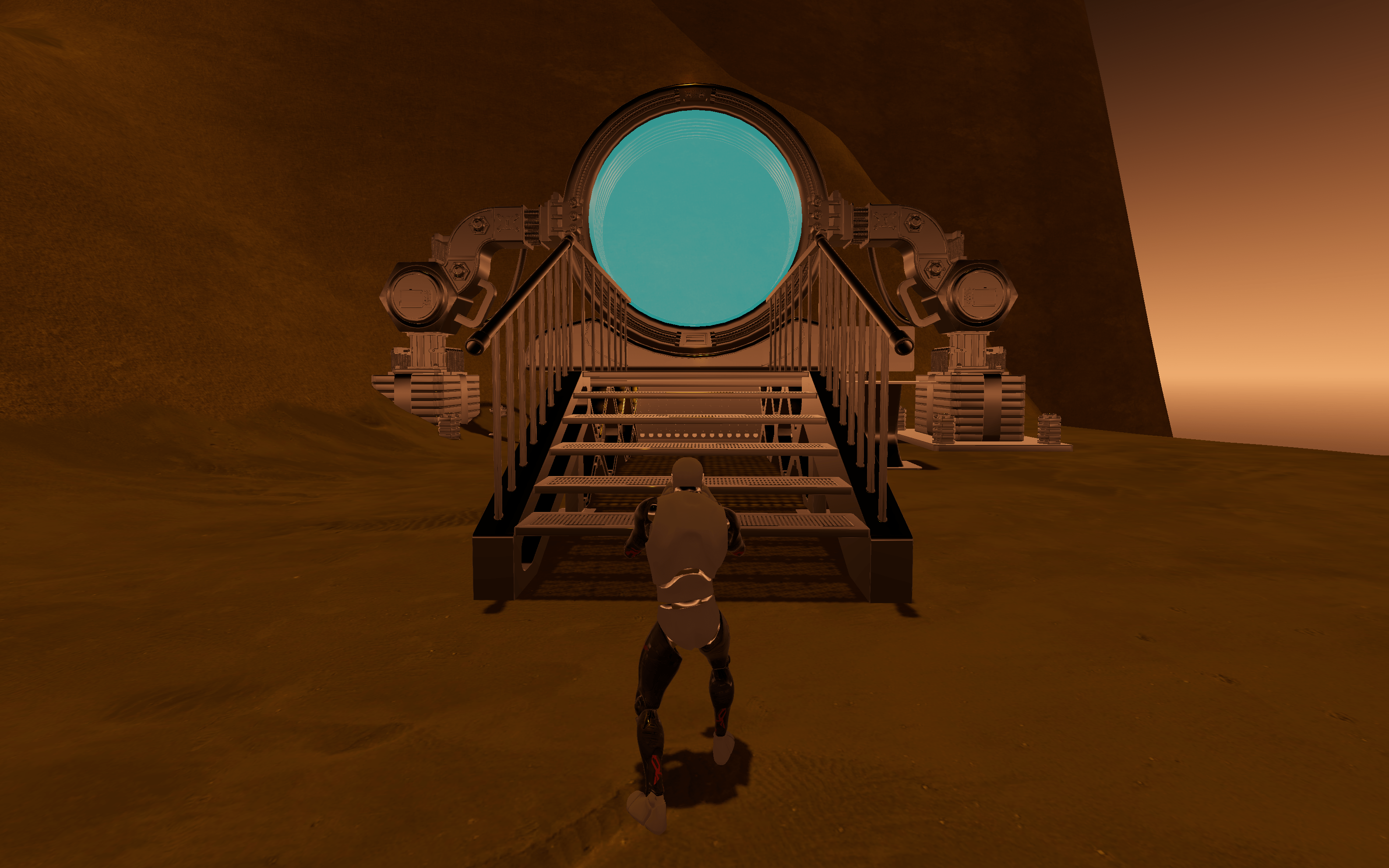
Each level is further divided into several areas with their own movement puzzles, each with a goal checkpoint that the player must attempt to reach. Some checkpoints unlock abilities that help the player complete the subsequent areas, while others are simply means to save and indicate progress.
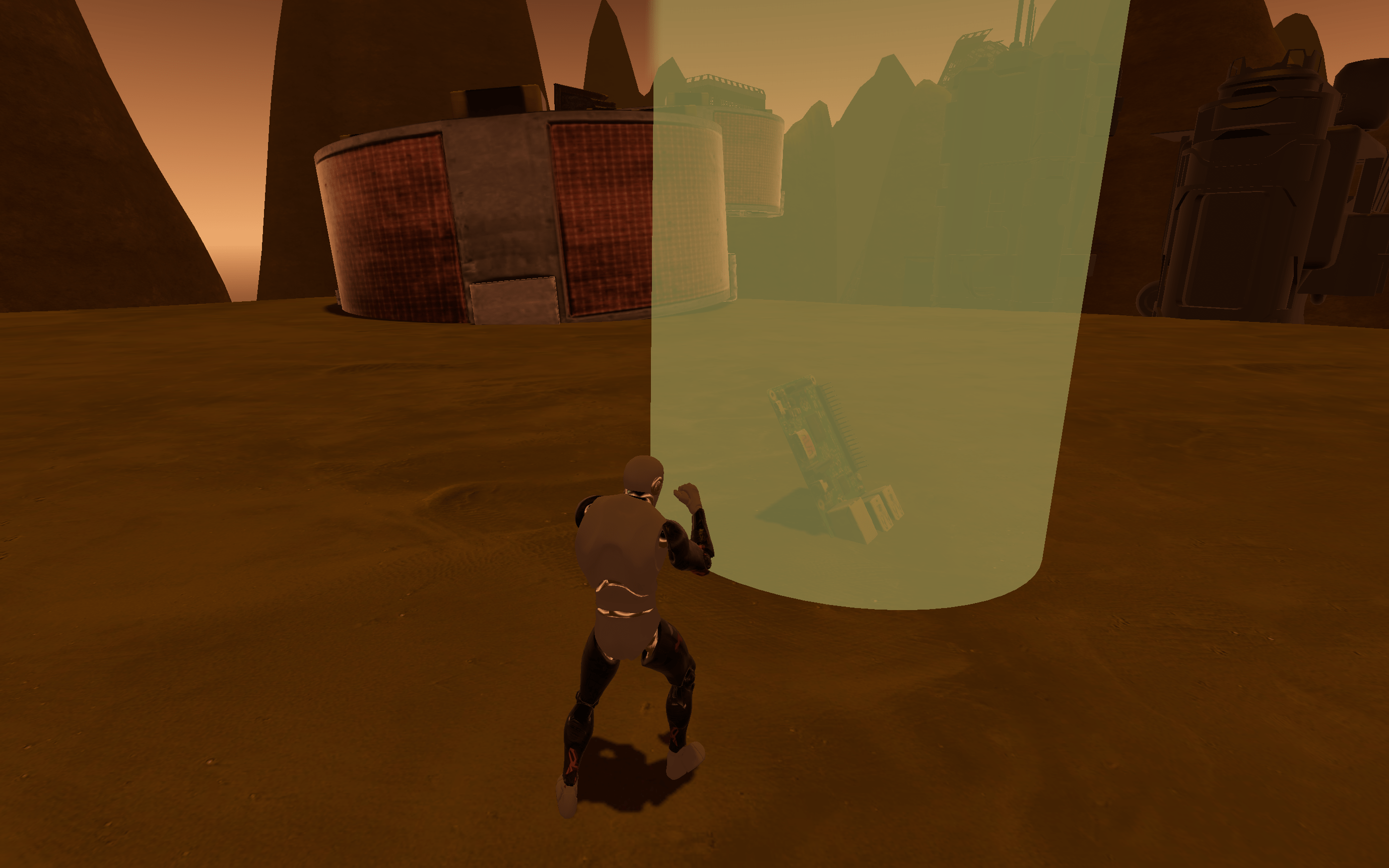
A side-objective of MoonRunner is to explore the world, with each level reflecting a different area of the same planet. By creating an open world with a variety of different structures, and giving the character navigation-centric abilities, we create an environment for free exploration.
Mechanics
Players can navigate with W/A/S/D or the left analog stick, and jump with Space or the square button on a controller. The camera view can be panned using the mouse or the right analog stick. The character unlocks three core abilities through exploration in the first level:
- Double Jump: Pressing the jump button a second time enables the player to jump higher and farther.
- Wall Running: By jumping laterally onto a wall, the player can run horizontally across walls.
- Grappling: To reach even higher elevations, the player is equipped with a grappling hook triggered using Q or the right trigger on the controller.
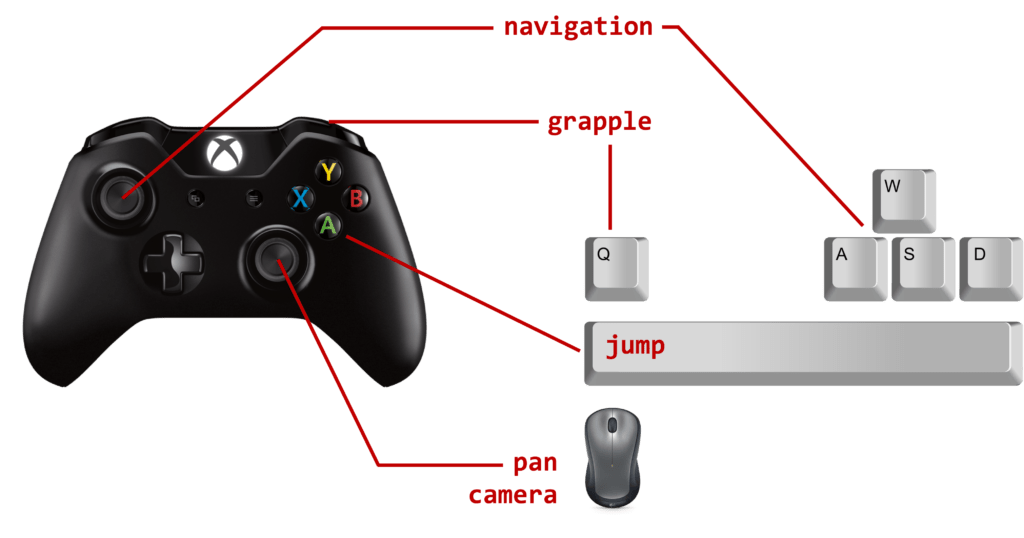
Types of Fun
The core aesthetics of MoonRunner are challenge and exploration, which we deliver on by creating a series of challenging movement puzzles that increase in difficulty, while allowing the player to discover the world that MoonRunner is set in, through guided exploration via puzzles that direct them in a certain direction, as well as free, unguided exploration using the abilities they pick up along the way. Additionally, through creating extensive lore and building towards a gestalt realization that the player’s character is the very being who created the world they are fighting against, the game delivers on the narrative aesthetic. We aimed to create sensation pleasure through a visual and auditory experience that is realistic yet fantastical and quite fast-paced. Finally, by allowing players to control a character with larger-than-life abilities stuck on a derelict planet, we deliver on fantasy; and by allowing the player to explore the world unhindered before they choose to jump into the waypoint and end the level, we allow them to simply turn off and play around, thereby delivering on the abnegation aesthetic.
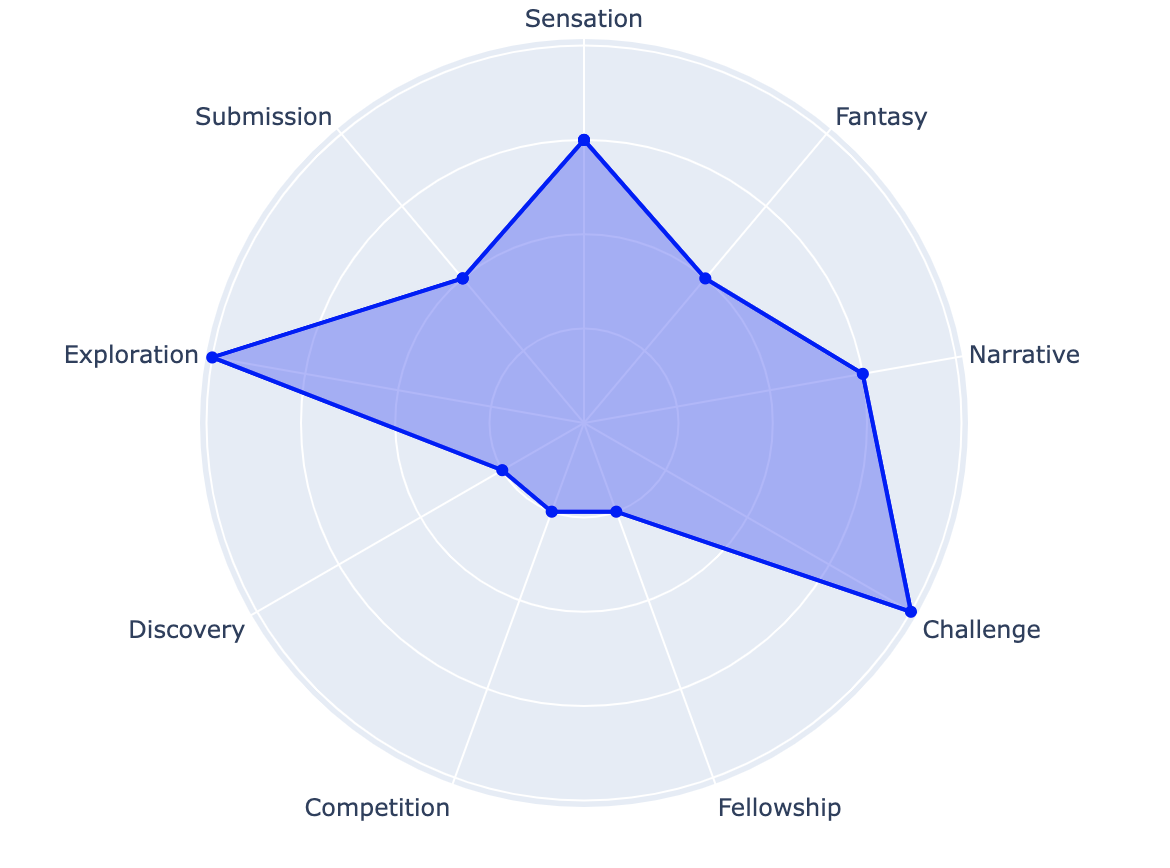
Narrative Architecture and the Use of Space
With extensive lore and a game experience that allows players to reconstruct and rediscover the plot, MoonRunner is an embedded narrative from Jenkins’ four types of narrative architectures. The backstory exists like a body of information, which complements the story that the player creates through navigating the character through the created space and interacting with the world.
Onboarding
In order to help players learn the game’s core mechanics without breaking immersion, we interwove the tutorial with the game. The first level can be thought of as a tutorial level, since the player gradually unlocks abilities (new mechanics) and learns how to use them by practice. Additionally, in order to keep the instructions accessible at all time, the key mappings for the core mechanics can be accessed at any time. By creating puzzles that require the player to continuously leverage the same set of abilities, we ensure that subsequent puzzles serve as reminders of previously learned mechanics.
Design and Process
Key Design Choices
Character Design
The main character is a humanoid robot with custom animations for the core mechanics. For our initial prototype, we modeled a medium-fidelity, cartoon-like character.
We ultimately shifted to a more expressive character. In keeping with the lore, the model is minimalistic in structure. All Runner models look the same except for their head mounts, which change color and texture (through using different Blender materials) to represent the extent of their power and abilities. The initial Runner in level 1 has a head mount made of blue reflective glass. For the second level, it morphs into a green cloudy glass. The Rogue model has an opaque red, textured plastic material.
Ability Design
We wanted the character’s abilities to enable the player to navigate difficult terrain, and also explore and interact with the world. The double jump allows the player to explore areas of higher vertical elevation using an existing mechanic (jump) that they were familiar with, but no additional interaction with the environment. The wall running ability allows the player to explore horizontally farther and more disconnected areas using the familiar running mechanic, and with added interaction with walls. The grapple hook introduces a completely new mechanic which makes even higher elevations accessible to the player, with an interaction that involves both the player (the source of the grappling hook) and the structures they grapple onto, and introduces added complexity in that the player has to aim the grappling hook with their camera panning mechanic. In order to ease the player into the grapple aiming mechanic, we provide them with a crosshair at the centre of the camera view from the very beginning, so that they learn to implicitly correlate the crosshair with the point the character is looking/aiming at.
World Design
We wanted to create a mind-bending and thought-provoking story with a world that inspires awe, wonder and mystery against the backdrop of dark and desperate elements. To match this tone and the lore, we wanted to combine sci-fi and mythological elements. Accordingly, the game world consists of a rough, mountainous terrain with a lot of vertical and horizontal variation, with various structures sprinkled throughout. These structures include some normal buildings, more artistic buildings with step-like sub-structures to encourage the use of the game mechanics, some futuristic-seeming buildings, towers reminiscent of Venetian architecture, and spaceships. Each level represents a different part of the world, and therefore uses a different terrain, set of structures, and materials. Here is a snapshot of a work-in-progress model of our second level, with new building asset, and a more well-defined mountainous terrain.
Puzzles and Level Design
Levels are divided into areas that exercise a specific set of abilities. Each area has a checkpoint that grants the player a new ability, or serves to save their progress. Based on playtest feedback, checkpoints disappear once they have been claimed.
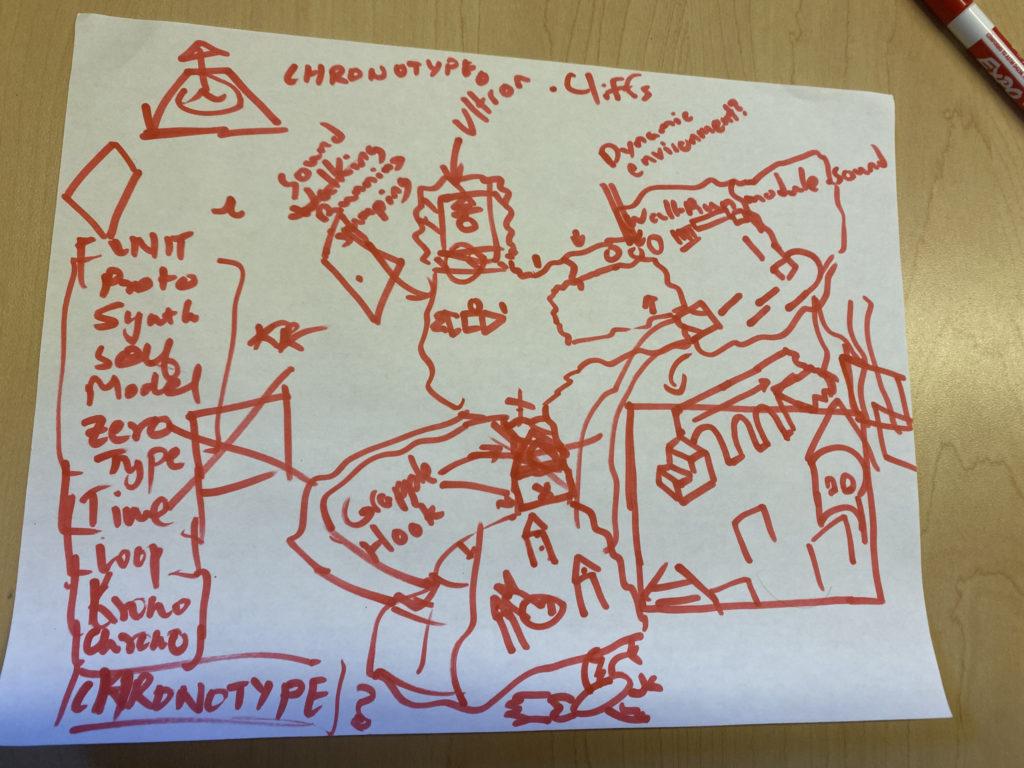
Our first level is intended to teach the player the mechanics, get the comfortable with their controls, and get them familiar with the game world, character, and the objectives. The level is divided into five primary regions, each with different movement puzzles that require different abilities to solve.
The first region is where the character spawns. Here, we want the player to get comfortable with their primary navigation controls. No abilities are needed, simply movement and jumps are enough to get to the first real checkpoint, where the user picks up the double jump ability.

This leads to the second region, where the player has to use the double jump ability to gain vertical distance in order to cross a long horizontal chasm between the plateau they are on, and the plateau they need to get to, where they unlock the wall running ability.
In the third region, the user is tasked with using wall runs and double jumps to get to the next landing. This puzzle is harder in that it involves not only leveraging the mechanics correctly, but also choosing one of two primary paths they can attempt.
Once on the next landing, the user gains the grappling ability. This is the hardest ability, so the puzzle is relatively simple to balance things out. There is a large chasm, with a single spaceship that is too high to double jump onto, but within grappling distance. The puzzle here is to identify which part of the spaceship to grapple onto – the bottom or the sides (hint: it’s the latter). This also increases familiarity with the structures in the world, since the spaceships that were earlier one-dimensional in that they could be jump on, can now be grappled onto the sides of. If you overshoot, you can land on the top of the spaceship and find yourself in familiar territory. If not, you hit the sides of the spaceship that you can then wall run across to orient yourself correctly.
Next, the user reaches a checkpoint with no new abilities. This is the main, large puzzle of the level, with almost ten structures that the user can leverage to get to the other side. There are several possible routes the user can take, with varying difficulties and chances of success. During playtests, we saw players use this area as a playground to explore the different routes or take on the challenge to reach a seemingly inaccessible structure or optimize for efficiency.
Finally, the player reaches the last checkpoint. They can choose to continue exploring the world, attempting to conquer other structures in the world, or they can end the level by jumping into the waypoint in front of them, which leads them to the cutscene that teases the next level.
Moodboard
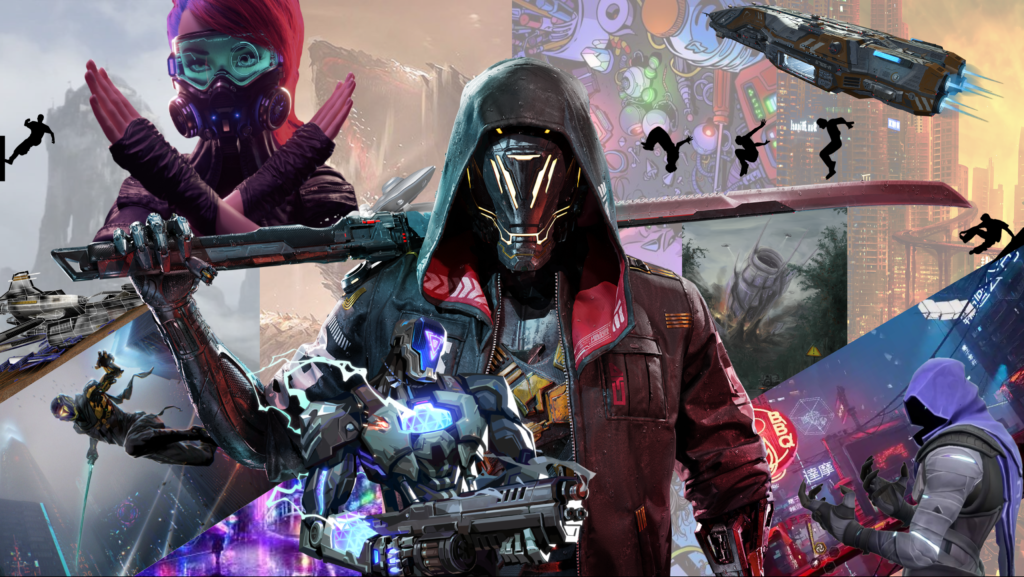
Concept Art
After creating our moodboard, we set on to synthesize our game’s mood and art directions by producing our own concept art. We believe that we managed to recreate the feelings evoked by these images in our final slice.
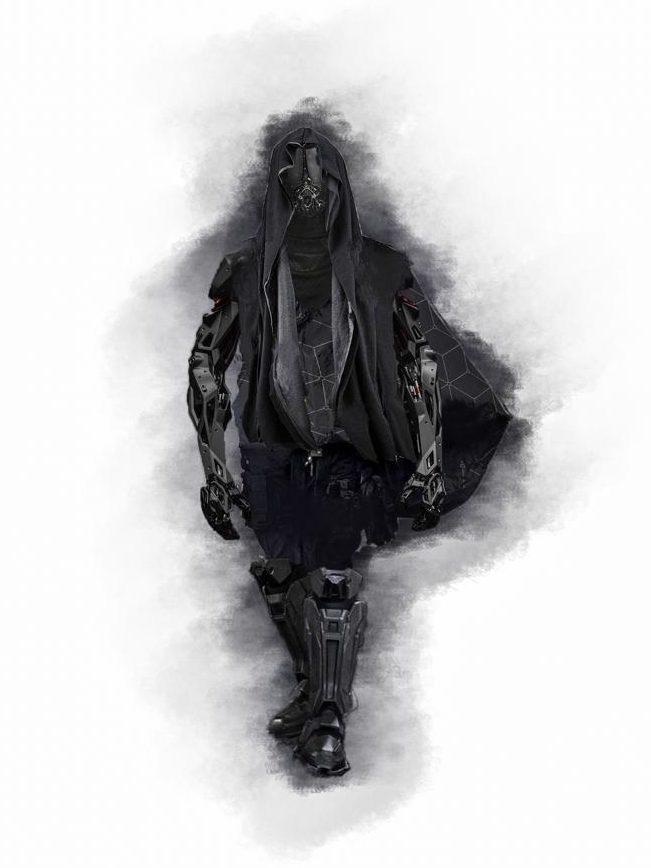
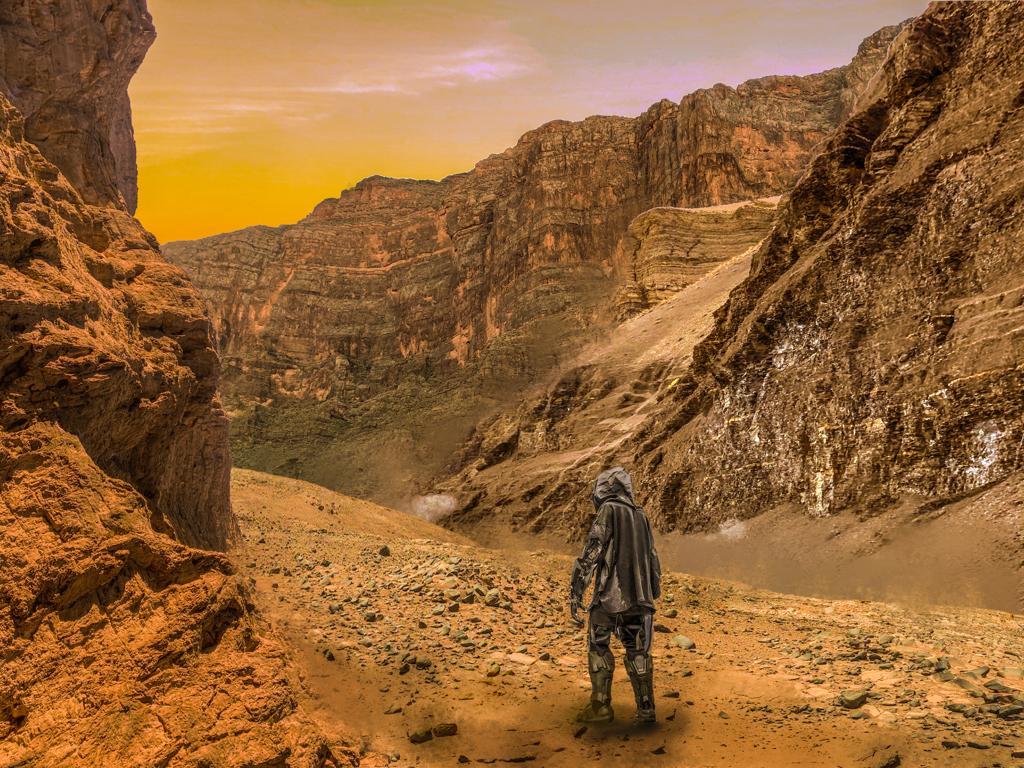
Testing and Iteration History
Playtest 1: Movement Demo
For our first playtest, we wanted to make sure our core movement gameplay was as solid as possible. We created an open-ended “playground” for our playtesters to test the movement however they wanted. Our objectives were to find any bugs or issues with the movement as well as observe what players naturally find fun and gravitate towards. We had a wide variety of people playtest this demo, from inexperienced gamers to more experienced gamers and even professional game developers. The experienced playtesters said that our game’s movement was satisfying and felt natural. The less experienced players felt they weren’t able to use the movement system to its full potential, which we took into account for the next iteration of our game. We also got feedback that the grappling hook was visually unclear (players weren’t sure what the character was doing). These changes were very useful when developing later versions of the game, as we really honed in on properly teaching the player how to play the game through the level design and progression. Instead of giving the player all abilities from the start to play around with, we gave players one ability at a time and then let them use the new ability to traverse a few obstacles before letting them acquire the next ability. Another key piece of feedback we received from most playtesters during this phase was a desire for a story which provided context and continuity to the play experience. They wanted to understand who the protagonist was and what they were doing on this alien planet. We incorporated this feedback heavily for later versions of the game, as we designed the levels based on our story and even included a cutscene to tease the world-building. Finally, through playtesting we honed in on a few bugs and unbalanced features of our game. For example, most players felt compelled to break the boundaries of our game, exiting the nicely structured play area we designed for them. We realized that blocking players with high structures was impossible because the grapple hook was too strong of a tool to break out of the enclosed mountain area. For the next version of the game, we designed a plateau area, where instead of blocking players with tall mountains, we had players die if they fell off the cliffs of the plateau. This made it impossible for players to break the boundaries of the game.
Playtest 2: Teaching the Player
For our second playtest, we focused on creating a more structured play experience which guides the player through the world. Rather than creating a free-form playground for the player to freely explore, we created a linear level where the player unlocked abilities one at a time and learned to use them. We found that with this change, playtesters became very comfortable with the game’s movement systems without us having to explain things. Even inexperienced players which lay outside our target audience were able to fumble through the level; this was a good sign that we landed on a good difficulty for our first level. The biggest thing playtesters felt was missing was strong thematic and world building cues which would provide both visual interest and story content. A lot of players said our game had a strong aesthetic (one playtester even said our world was “beautiful”) but felt that the environment lacked context; they wanted buildings, spaceships, or anything that would provide purpose to the protagonist’s journey. This is the main thing we focused on developing as we prepared for the third playtest. We created a new character model and environmental assets in order to reflect the game’s lore within the level itself. We wanted to communicate the post-apocalyptic nature of the game’s planet and the power struggle going on between the protagonist and its future self.
Playtest 3: Game Aesthetics and Player Instruction
For our final playtest, we created a fleshed out and visually appealing game world. Interestingly, some experienced playtesters likened our game to one of our inspirations, Titanfall. This was a sign that our game correctly communicated the dark sci-fi tone we were going for. Playtesters were intrigued by the world and felt it was a good example of post-apocalyptic sci-fi fiction. During this playtest, what players wanted to see most was combat, a feature which we imagined would be included in the next level of this game. On the other hand, some playtesters felt lost in certain parts of the world. They couldn’t tell which direction they came from and which direction they should head in. Part of the problem was that our checkpoints would all be lit at the same time; for the final version, we lit one checkpoint at a time to clearly indicate the direction the player should head in. Furthermore, some casual players felt the game was too difficult for them to complete easily. However, they reported a sense of satisfaction when completing obstacles, particularly saying “that was so cool” after completing a successful wallrun. Based on this final playtest, we would try to make the user experience even more refined for beginner gamers, while adding optional challenges for experienced players. Furthermore we would develop the game’s lore even more to add a large variety of environments for the player to explore.
Playtest Feedback: Other Games
Notes (Alejandro)
One notable game I played during the final playtest was Notes, on the team’s computer, moderated by Grace Zhou and notetaked by Ashley Chen. The game was a puzzle-solving, music-centric game where players have to mimic a series of notes in order to solve a puzzle and progress to the next stage. I would say that this game has a very wide target audience and is capable of reaching people of almost any age; the biggest limiting factor would be the difficulty of the puzzles, which I as a playtester didn’t get to experience since the game wasn’t fully fleshed out yet. The game’s primary formal elements are the player character, which moves like a simple 3d platformer character, the sound squares, which each have their own color, musical note, and height, and the sound cue which plays to let the player know what they have to imitate. These elements would likely come together cleanly to make a short, satisfying puzzle, but the current implementation wasn’t complete enough for me as a playtester to confirm that. I could see the game having three types of fun; sensation, since it heavily engages the sense of sound through music, challenge, because it engages the player’s memory skills, and submission, because the game has a relaxed atmosphere. The only one of these it didn’t meet yet is submission because there is not enough content to fully melt into the game. The successful parts of the game were its colorful aesthetic and quality music, however a failure was the lack of polish and functional code. This is forgivable given that it is a prototype, but I would’ve liked to see a more complete version of this game. To make this game better I would iron out the problems with the code to make the game fully functional, add characters and a clear story, and add variety to the game through new mechanics in new levels.
SpaceMail (Manan)
A notable game I played was SpaceMail, a story-based chore simulator game that draws elements from observation games. We play as a mail delivery employee who picks packages from and delivers them to one of five different planets in order to earn money to free their family from the government. But some packages may contain contraband, material that can help a rebellion against the government. We can choose to incinerate or continue with delivering these packages, and these decisions make the story diverge into four different endings after three days in the game world. Delivering the contraband may increase the chances of the rebellion succeeding, but we get a citation for each such package, which causes us to lose money. Incinerating the packages may have had a cost, but I did not discover this cost during my play session. We are shown the source and destination for the next package we are tasked with delivering.
The core mechanics, including navigating the ship in the game world using arrow keys to reach different planets. Once at the source planet, we can click a button to pick up the package, the details of which become visible in a dashboard in the lower half of the screen. Once picked up, the package can be dragged into the “incinerate” area to the left of the dashboard at any point. Once at the destination planet, the package can be dragged to the “deliver” area to the right of the dashboard to complete the delivery task. Both of these methods mark the end of the package’s lifecycle, which progresses the story and we receive details for the next delivery task. SpaceMail is well-made with good graphics. Story-based observation games can be quite monotonous when long, and SpaceMail keeps each day short.
One piece of feedback on this point is that there isn’t a way of telling how far along the day one is. A method used by other such games is to limit each work day to, say, a 5-hour shift between 1am and 6am and showing a clock with the current time, in order to help players orient themselves better.
An issue that such games encounter is making each subtask fun and rewarding. Most such games that I’ve previously encountered have been in the horror genre and have made sub-tasks fun by delivering on the sensation aesthetic. For example, I’m on Observation Duty makes the player look at a series of security cameras and report anomalies like an object having changed orientation, or an intruder having entered a room. This creates space for jump scares, so each time a player has to switch to a new camera, there is a sense of terror. This is hard to achieve in SpaceMail since the stimuli (package text and citations) are more passive (the player needs to carefully read them in order to be affected by them) and the chore being simulated involves navigation around a world that is entirely visible at all times. While playing, I found myself trying to derive fun out of each subtask (delivery) by trying to remember where each planet was and navigating to the right planet without having to read the planet names.
Overall, I found SpaceMail to be quite fun, and was impressed by the smooth gameplay and design!
Ghostly Stars (Noel)
I played through the first level of Ghostly Stars, a story-rich and visually striking 2D platformer. The player takes control of a small kid who has climbed his way up a residential building to do some stargazing as the night begins to fall. The player is introduced to hints of the story through environment interactions such as listening to radio channels and eavesdropping on conversations as we climb through the lit-up windows. I thought it was particularly clever and funny how the DJ Tutorial character was introduced in the game as well as how it managed to deliver a fun and nonintrusive tutorial through dialog and exposition. At the beginning of the level, the player is standing on a roof with a radio nearby which they are prompted to interact with. After an initial exposition that introduces the goal of the game, reaching a higher roof for stargazing, DJ Tutorial describes how to perform the basic movements such as jumping and double jumping and introduces the player to the “lit windows” mechanic. While the visual cues of illuminating the jumpable windows or platforms to make them stand out works very well, I believe that specifying how non-lit windows cannot support the player saved me from a couple of “test jumps” back to the previous checkpoint. I also found the star collection feature to be very intuitive and liked how the positioning of the stars served to guide the player throughout the level. Lastly, the electrical wire challenge was a nice change of pace from the regular window jump gameplay loop and was, in fact, one of the most challenging sections of the level. I also liked the bouncing feature, although I believe the “strength” of the bounce should’ve been lowered in order to keep the player and the next section of the level in the same frame, as initially, it caused some confusion as to where to head next as the screen was moving quite aggressively. In the same vein, I found the dog interactions to be quite unexpected and gameplay-breaking. The lack of auditory and visual cues kept me returning to a section of the level which I was not supposed to access as it was guarded by a dog. The goal then was to take an alternate route and distract the dog before attempting to move in the initial direction. I was not able to understand this puzzle and thus “died” multiple times and needed an intervention from the team to tell me the exact goal and solution.
With regards to the art direction and story, I really enjoyed the wholesome yet devastating premise of the game. Visuals and audio create a very warm and welcoming atmosphere, a little surreal at times, as the buildings are quite detailed and washed in neutral tones in an effort to look realistic, while the sky and the main character remain bright against that backdrop, yet as the player progresses through the level and is exposed to bits of dialog detailing the death of the main character the experience becomes increasingly bittersweet. One detail that I’d like to see added in a future version is the sky darkening and the stars becoming more apparent as the player progresses through the level or moves on to a new level. Overall the game certainly delivered an enjoyable narrative experience.



